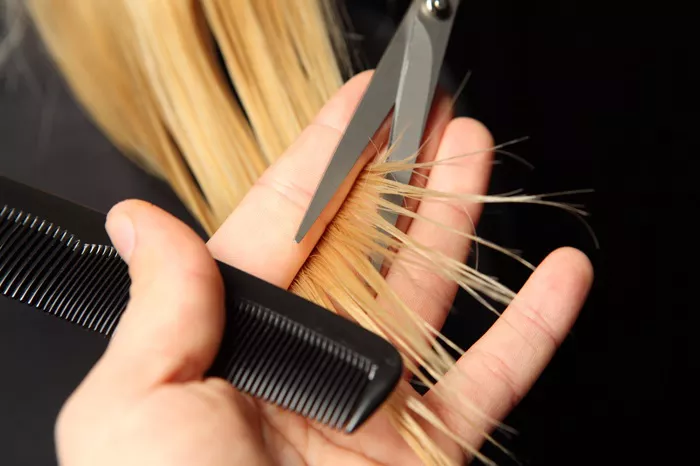Split ends are one of the most common hair problems many people face. They can make your hair look dry, damaged, and unhealthy, no matter how much effort you put into styling or caring for it. The good news is that you don’t always need to rush to a salon to fix split ends. With the right knowledge and techniques, you can safely trim split ends at home and keep your hair looking fresh and vibrant between professional cuts.
In this article, I will share detailed tips recommended by professional hairstylists to help you understand why split ends occur, how to spot them, and the best way to trim them without causing further damage. Whether you have long, short, curly, or straight hair, these practical tips will guide you step-by-step so you can maintain healthy hair from the comfort of your own home.
Why Do Split Ends Form and Why Should You Trim Them?
Split ends happen when the protective outer layer of your hair strand wears down or breaks, exposing the inner core. This can be caused by heat styling, chemical treatments, harsh brushing, or even environmental factors like sun exposure and pollution. Over time, split ends make your hair look frizzy and brittle, and if left untreated, they can travel further up the hair shaft, causing more breakage and damage.
Trimming split ends is important because it helps prevent the damage from worsening. Unlike some hair issues that can be fixed with conditioners or oils, split ends are permanent once they occur. The only way to truly get rid of them is by cutting them off. Regular trimming also encourages healthier hair growth and gives your hair a fuller, more polished look.
How to Identify Split Ends Before Trimming
Before you grab your scissors, it’s essential to clearly identify which parts of your hair need trimming. Split ends don’t always look dramatic at first glance, especially if your hair is thick or curly. The best way to check is by taking a small section of hair between your fingers and sliding your fingers down towards the ends. If the strands feel rough, look uneven, or split into two or more pieces, those are split ends.
Using a magnifying mirror or a bright light can also help you spot tiny splits you might miss otherwise. Remember, it’s better to trim smaller sections carefully rather than cutting large chunks all at once. This reduces the risk of removing too much length or accidentally cutting healthy hair.
What Tools Do You Need for Trimming Split Ends at Home?
Having the right tools is crucial to achieving a clean, effective trim. The most important tool is a pair of sharp hair-cutting scissors. Avoid using regular household scissors or dull blades as they can cause further damage by crushing or tearing the hair strands.
Some hairstylists also recommend having a fine-tooth comb, hair clips for sectioning, and a spray bottle filled with water to lightly dampen your hair. Damp hair is easier to manage and cuts more smoothly. Additionally, good lighting and a comfortable, well-lit space will make the trimming process easier and more precise.
Step-by-Step Guide to Trimming Split Ends at Home
Start by washing and conditioning your hair as usual. Towel dry gently to remove excess water but keep your hair slightly damp. Comb through to detangle any knots. Then divide your hair into small, manageable sections using clips.
Take a small section between your fingers and locate the split ends by feeling for rough or uneven edges. Hold the hair firmly and trim just above the split, cutting only a tiny amount—usually about a quarter to half an inch. Avoid cutting too much length in one go. Move systematically through each section until you have trimmed all visible splits.
After trimming, rinse and style your hair as desired. You will likely notice smoother ends and less frizz. Repeat this process every 6 to 8 weeks to maintain healthy hair between professional salon visits.
Tips to Prevent Split Ends in the Future
Trimming split ends is only part of the solution. To keep your hair healthy and minimize future splits, it’s important to adopt protective hair care habits. Avoid excessive heat styling and always use a heat protectant spray when you do. Limit chemical treatments like bleaching or perming that can weaken hair fibers.
Use a wide-tooth comb instead of a brush on wet hair to prevent breakage. Choose shampoos and conditioners that hydrate and strengthen hair. Regularly deep condition or apply hair masks to restore moisture. Finally, protect your hair from environmental damage by wearing hats or using UV protection sprays when spending long hours in the sun.
When Should You See a Professional Stylist?
While home trimming can manage minor split ends and keep your hair looking fresh, it is not a replacement for professional haircuts. If your split ends are severe or widespread, or if you want a specific style or shape, visiting a hairstylist is the best option.
Professionals have the training, experience, and tools to trim hair precisely and recommend treatments that can improve overall hair health. They can also advise you on the best hair care routine tailored to your hair type and condition.
Conclusion
Splitting ends don’t have to be a constant frustration. By understanding what causes them and learning how to trim them properly at home, you can extend the life of your haircuts and keep your locks looking smooth and healthy. Remember to invest in quality tools, take your time, and handle your hair gently.
Combine regular trims with good hair care practices, and you’ll reduce split ends, promote stronger hair growth, and enjoy the confidence that comes with vibrant, well-maintained hair. With these hairstylist-recommended tips, trimming split ends at home can be a safe, effective, and empowering part of your hair care routine.
Related Topics:

